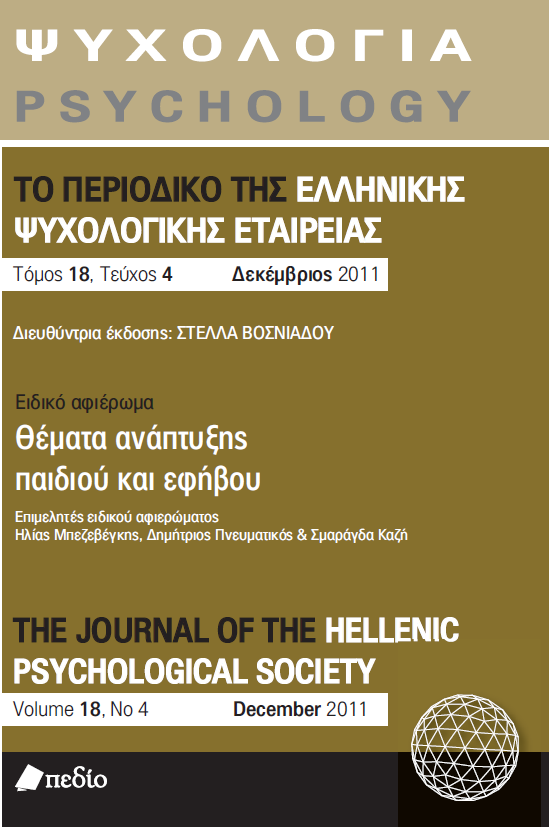Σχολικός εκφοβισμός και θυματοποίηση: Ατομικές και οικογενειακές παράμετροι

Περίληψη
Σκοπός του παρόντος άρθρου είναι η περιγραφή των παραγόντων που συνεισφέρουν στη δημιουργία του φαινομένου του σχολικού εκφοβισμού και της θυματοποίησης. Η βιβλιογραφική ανασκόπηση έχει αναδείξει τρεις διακριτές ομάδες παιδιών που συμμετέχουν σε περιστατικά σχολικού εκφοβισμού και θυματοποίησης: τους θύτες, τα θύματα και τους θύτες-θύματα. Οι ομάδες αυτές παρουσιάζουν διαφορές τόσο ως προς τα ατομικά χαρακτηριστικά όσο και ως προς το οικογενειακό πλαίσιο. Οι κυριότεροι ενδοατομικοί παράγοντες αφορούν την ιδιοσυγκρασία, την ψυχοπαθολογία, το φύλο και την ηλικία του παιδιού. Επιπρόσθετα, ο βαθμός διαφορετικότητας των παιδιών, καθώς και οι εξηγήσεις της βίαιης συμπεριφοράς (αιτιακές αποδόσεις) των θυτών φαίνεται να αποτελούν παράγοντες που προβλέπουν την έκφραση εκφοβιστικής συμπεριφοράς.
Όσον αφορά τους οικογενειακούς παράγοντες, διαφάνηκε ότι η γονική εμπλοκή, το γονικό στυλ και η γονική κατάθλιψη συνεισφέρουν σημαντικά στην εμφάνιση του φαινομένου. Πολλοί ερευνητές έχουν καταλήξει σε ποικίλα μοντέλα περιγραφής των σχέσεων μεταξύ των προαναφερθέντων παραγόντων, με πιο σύγχρονα τα διαδραστικά μοντέλα, στα οποία περιγράφονται αμφίδρομες σχέσεις μεταξύ γονέων-παιδιών.
Λεπτομέρειες άρθρου
- Πώς να δημιουργήσετε Αναφορές
-
Ν. Γεωργίου Σ., & Φαίδωνος Φ. (2020). Σχολικός εκφοβισμός και θυματοποίηση: Ατομικές και οικογενειακές παράμετροι. Ψυχολογία: το περιοδικό της Ελληνικής Ψυχολογικής Εταιρείας, 18(4), 484–502. https://doi.org/10.12681/psy_hps.23735
- Τεύχος
- Τόμ. 18 Αρ. 4 (2011)
- Ενότητα
- ΕΙΔΙΚΟ ΑΦΙΕΡΩΜΑ

Αυτή η εργασία είναι αδειοδοτημένη υπό το Creative Commons Attribution-ShareAlike 4.0 International License.
Το περιοδικό ΨΥΧΟΛΟΓΙΑ έχει υιοθετήσει μία πολιτική Platinum open-access. Τα έξοδα υποβολής, επεξεργασίας ή δημοσίευσης των εργασιών καλύπτονται από την Ελληνική Ψυχολογική Εταιρεία. Τα πνευματικά δικαιώματα των δημοσιευμένων εργασιών προστατεύονται από την άδεια 'Creative Commons Attribution-ShareAlike 4.0 International'. Οι Συγγραφείς διατηρούν τα Πνευματικά Δικαιώματα και χορηγούν στο περιοδικό το δικαίωμα της πρώτης δημοσίευσης. Η άδεια αυτή επιτρέπει σε τρίτους, να χρησιμοποιούν την εργασία σε οποιαδήποτε μορφή, με την προϋπόθεση της διατήρησης των διατυπώσεων που προβλέπονται στην άδεια σχετικά με την αναφορά στον αρχικό δημιουργό και την αρχική δημοσίευση στο περιοδικό ΨΥΧΟΛΟΓΙΑ. Επιπλέον, κάθε διανομή της εργασίας οφείλει να γίνεται με τους ίδιους όρους διανομής, δηλαδή με την ίδια άδεια Creative Commons.



